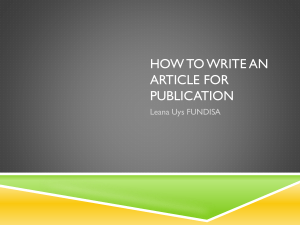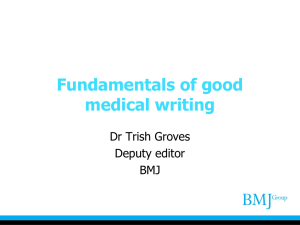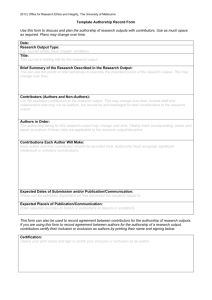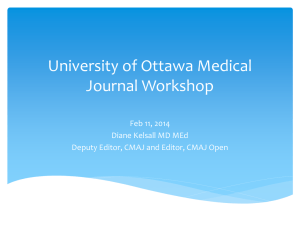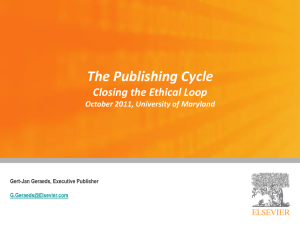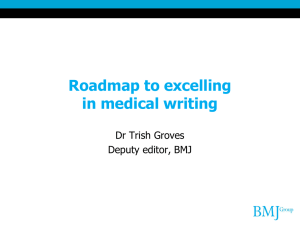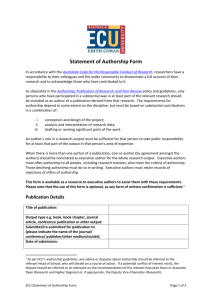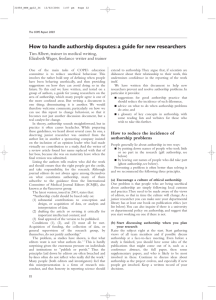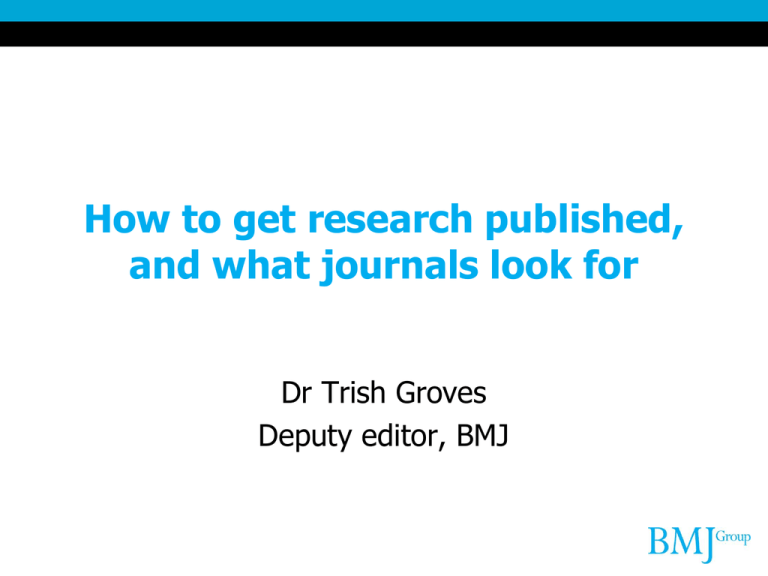
How to get research published,
and what journals look for
Dr Trish Groves
Deputy editor, BMJ
What I aim to cover
Planning research
The research question
Why you need to publish
What editors want
How to write a paper
Useful resources
Publication ethics
How to please editors and peer reviewers
Why conduct and publish research?
say something important
share your work
change practice
promote thought or debate
educate
get into high impact journal
advance your career
Keep your job
make money
entertain/divert/amuse
Steps in starting research
turn your ideas into a research question
review the literature
enlist coauthors, statistician, supervisor
agree who’ll do what
design the study and develop your methods
think about the ethics of your study design
write your research proposal
apply for funding and ethics approval
The research question
What is a research question?
The researcher asks a very specific question and tests
a specific hypothesis. Broad questions are usually
broken into smaller, testable hypotheses or
questions.
Often called an objective or aim, though calling it a
question tends to help with focusing the hypothesis
and thinking about how to find an answer
What makes a poor research question?
a question that matters to nobody, even you
hoping one emerges from routine clinical data/records
– the records will be biased and confounded
– they’ll lack information you need to answer your
question reliably, because they were collected for
another reason
fishing expedition/data dredging – gathering new data
and hoping a question will emerge
How to focus your question
brief literature search for previous evidence
discuss with colleagues
narrow down the question – time, place, group
what answer do you expect to find?
Turning a research question into a proposal
who am I collecting information from?
what kinds of information do I need?
how much information will I need? *
how will I use the information?
how will I minimise chance/bias/confounding?
how will I collect the information ethically?
* sample size – ask a statistician for help
http://www.bmj.com/collections/statsbk/13.dtl
Minimising bias and confounding
Chance - measurements are nearly always subject to random
variation. Minimise error by ensuring adequate sample size and
using statistical analysis of the play of chance
Bias - caused by systematic variation/error in selecting patients,
measuring outcomes, analysing data – take extra care
Confounding - factors that affect the interpretation of outcomes
eg people who carry matches are more likely to develop lung
cancer, but smoking is the confounding factor – so measure likely
confounders too
Ethical issues – the wider aspects
• what information will you give participants before
seeking their consent?
• how much will the study deviate from current
normal (accepted, local) clinical practice?
• what full burden will be imposed on participants?
• what risks will participants/others be exposed to?
• what benefit might participants or others receive?
• how might society/future patients benefit in time?
• might publication reveal patients’ identities?
Exactly what are you planning to do?
PICO/PECO
P - who are the Patients or what’s the Problem?
I or E - what is the Intervention or Exposure?
C – what is the Comparison group?
O - what is the Outcome or endpoint?
Study designs
Descriptive studies answer “what’s happening?” research questions
Analytic observational studies answer “why or how is it happening?”
Analytic experimental studies answer “can it work?”
Centre for Evidence Based Medicine, Oxford, UK www.cebm.net
Who will do what?
agree authorship
before starting the study!
Authorship and contributorship
these denote credit and accountability
but many authors on papers have done little
people’s names are left off papers
authors do not know the authorship criteria
contributorship statement more inclusive
Authorship
Authorship credit should be based only on substantial
contribution to:
• conception and design, or data analysis and interpretation
• drafting the article or revising it critically for important
intellectual content
• and final approval of the version to be published
All these conditions must be met.
Participation solely in the acquisition of funding or the collection
of data does not justify authorship.
All authors included on a paper must fulfil the criteria
No one who fulfils the criteria should be excluded
Contributorship
contributors (not all necessarily authors) who took part
in planning, conducting, and reporting the work
guarantors (one or more) who accept full
responsibility for the work and/or the conduct of the
study, had access to the data, and controlled the
decision to publish
researchers must decide among themselves the precise
nature of each contribution
Who did what?
Helen C Eborall, post-doctoral research fellow1, Simon J
Griffin, programme leader2, A Toby Prevost, medical
statistician1, Ann-Louise Kinmonth, professor of general
practice1, David P French, reader in health behaviour
interventions3, Stephen Sutton, professor of behavioural
science1
Contributors: SS, DPF, ATP, A-LK, and SJG conceived and
designed the original protocol. All authors were involved in
amending the protocol. HCE coordinated the study throughout.
Data entry was carried out by Wyman Dillon Ltd, Lewis Moore,
and HCE. HCE cleaned the data and ran preliminary analysis
with input from Tom Fanshawe. ATP analysed the data.
ADDITION trial data were supplied by Lincoln Sargeant and
Kate Williams. HCE wrote the first draft of the manuscript with
ATP and SS. All authors contributed to subsequent and final
drafts. HCE is guarantor of the paper.
Writing a research paper
General guidance on writing papers
International Committee of Medical Journal Editors
uniform requirements for manuscripts submitted to
biomedical journals
http://www.icmje.org/
reporting guidelines for research, at the EQUATOR
network resource centre
http://www.equator-network.org/
More on study methods and reporting
Centre for Evidence Based Medicine
http://www.cebm.net/
Statistics at Square One
http://www.bmj.com/collections/statsbk/index.dtl
BMJ advice to authors
http://resources.bmj.com/bmj/authors
Writing a paper
1. The message
What
…is the research question?
…is the right article format for your study?
…does the audience need to know?
Writing a paper
2. IMRaD
Introduction: why ask this research question?
Methods: what did I do?
Results: what did I find?
Discussion: what might it mean?
Writing a paper
3. The introduction
brief background for this audience
3-4 paragraphs only
what’s known, and what’s not, about your research question
don’t bore readers, editors, reviewers
don’t boast about how much you have read
the research question
state it clearly in the last paragraph of the introduction
say why it matters
Writing a paper
4. Methods
like a recipe
most important section for informed readers
describe:
inclusion and exclusion criteria
outcome measures
intervention or exposure
give references for standard methods
follow reporting guidelines as explained at
(http://www.equator-network.org/
explain ethics issues
Writing a paper
5. Results
include basic descriptive data
text for story, tables for evidence, figures for highlights
confidence intervals
essential summary statistics
leave out non-essential tables and figures
don’t start discussion here
Writing a paper
6. Structured discussion
don’t simply repeat the introduction
include
– statement of principal findings
– strengths and weaknesses of the study
– strengths and weaknesses in relation to other studies
(especially systematic reviews), and key differences
– meaning of the study: possible mechanisms and implications
for clinicians or policymakers
– unanswered questions and future research
go easy on the last two
Abstract: general rules
important
all authors must
approve it
editors may screen by
abstract
for BMJ:
usually 300-400 words
use active voice
p values need data too
%s need denominators
no references
trial registration details
Structured abstract
objectives - research question
design –prospective, randomised, placebo controlled, case control, etc
setting – primary or secondary care? number of centres, country
participants – entry and exclusion criteria, numbers entering and
completing the study, sex, ethnic group as appropriate
interventions - what, how, when and for how long
main outcome measures - those planned, those finally measured
results - main results, 95% confidence intervals, statistical significance,
number need to treat/harm
conclusions – primary conclusions, implications; don’t go beyond data
trial registration - registry and number (only for clinical trials)
How to please editors and reviewers
How to please editors and peer reviewers
make sure the message is clear in the paper and
abstract, not just in the cover letter
include extras eg STROBE checklist
cite (and send) any closely related papers
send previous peer review reports
communicate clearly and promptly


